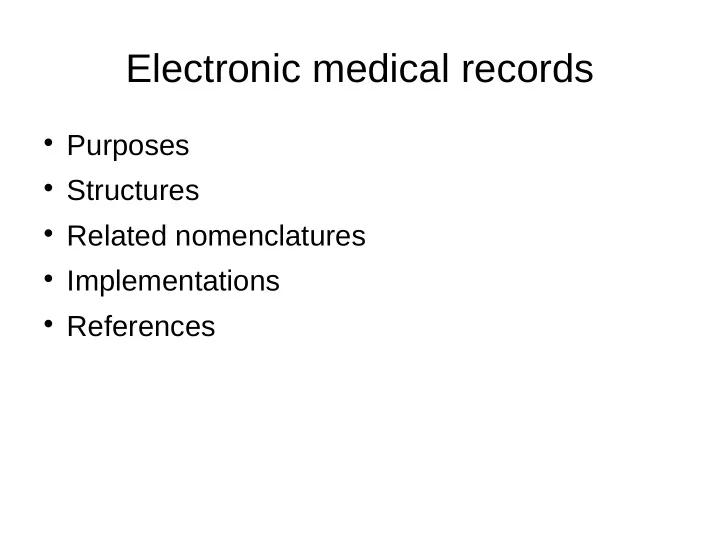

Electronic medical records Purposes Structures Related nomenclatures Implementations References
Purposes Collecting relevant data Reporting Management of medical data Administrative management Attestation and defending the patient Correspondence
Purposes EMR is a communication tool Between health workers Between GP's and hospitals Towards the patient
Purposes This means WORK! Who will do it? General Practitioner best placed (Patient- centric medicine!) Patient rights? … Full access EXCEPT for “personal notes” of the physician Patients'own data input?? Health Vault, Google Health??
Structures 1. Journal (log-book) 1. SOAP registration 1. Segmented record 1. Pre-conditions/context of the patient 2. Mode of life/ habits 3. Pregnancy record 4. POMR (Problem Oriented Medical Registration) 5. Problem list 6. Diabetes record 1. Episode registration
Structures 1 patient + 1 physician + 1 contact: case:
Structures 1 patient + 1 physician + 1 contact: case: S S Subjective element: patient's complaint O O Objective measurement A A Action taken P P Planning: what next? Care plan? Clinical path?
Structures Problem Oriented Medical Registration (POMR) Patient Patient (central element) Health agent Health agent Health care element Health care element Health approach Health approach Service(s) Service(s) Contact/sub-contact Contact/sub-contact
Structures Problem Oriented Medical Registration (POMR)
Structures Problem Oriented Medical Registration (POMR)
Structures Problem Oriented Medical Registration (POMR)
Structures Problem Oriented Medical Registration (POMR)
Structures Problem Oriented Medical Registration (POMR)
Structures Health Care Element : Health Care Element : Can be defined by any item in the patient record describing the patient’s state of health and for which something is (has been) done by a health professional. A Health Care Element is addressed by at least one service A Health Care Element is related to one defined patient and to one specific problem (item). Most of the time, this problem (item) can be identified by a diagnosis, by a patient’s complaint, a risk factor, a life condition, ...
Structures Health Care Element : attributes Health Care Element : attributes 1 p at ien t + 1 “p r o b lem ” • La b el(s ) • d at e s t a r t • d at e en d • in d ex gr a vit y, cer t it u d e, ... • a ct ive / in a ct ive • et c.
Structures Health Approach Health Approach Comprises all that has been done • by 1 health agent • with a specific objective • within one health care element Enables to differentiate the actions taken by different members of a health team: Physician (apporoach = “follow-up”) Surgeon (approach = “sugery”) Physiotherapist (approach = “re-education”) Nurse (approach = “pain control”) All in the context of a single health care element: “broken leg”
Structures Contact Contact Any interaction between a professional and a patient • with or without encounter • includes at least 1 service • related to a single health agent
Structures Subcontact Subcontact Part of a contact dedicated to a single health approach • including all services related to a health approch • could be SOAP structured
Structures Service Service Recording (data entry) into the EPR of information related to any activity or process performed by the health professionals. Any data in the EPR is introduced through service. A service is related (directly or indirectly) to only one Health Agent. A service may be related to several sub-contacts (of the same contact), and thus to several Health Approaches (of a same Health Agent) and to several Health Care Elements (of a same patient).
Structures Problem Oriented Medical Registration (POMR)
Structures: POMR
Structures: POMR
Structures: POMR
Structures: POMR Routine: journal + link to health element(s)
Structures: POMR Routine: journal + link to health element(s)
Structures: POMR Plan service(s)
Structures: POMR Adjust planning
Structures: Problems versus HCE Problem Problem = an issue specifically flagged as a problem active or inactive difference “inactive” “previous problem” Health care element = Health care element = An issue for which the health care provider did/ does something What he does: is a service service
Structures: Episode recording What is an “health care episode”? Simple cases: pregnancy, flue Chronic cases: beginning? End: death of the patient Difficult: end unknown: patient feels OK Un-noticed episodes: contaminations ...
Structures: Episode recording What is a period period ? Examples: Phase: acute phase / remission Groupings of episodes of care for a specific problem linked to a specific health element and (1- n) approaches Event: hospitalization
Structures: Episode recording
Structures: Episode recording
Structures:View Presentation of data and different characteristics visualizing a care concept such as: Antecedents Problem list Episode list Laboratory data Hospital results
Active record management An electronic health record MUST BE MANAGED Medication interactions Therapy faithfullness of the patient Planning and active follow-up Risk assessment and behavior follow-up Overviews and summaries (SUMEHR) Audits Integration from external sources
Active record management An electronic health record MUST BE MANAGED Some useful register selections: Integration of vaccinations Generating listings: which patients need urgent attention? Age and gender register Smears register Call-back register Diabetes Mellitus register
Active record management An electronic health record MUST BE MANAGED Useful (sometimes obliged) reporting: Quality reporting (regional groups) Registration of urgent cases Reporting of infectuous diseases Participation in vaccination actions Surveillance
Active record management An electronic health record MUST BE MANAGED Moving /death of patients Family / living together links Lab and other reports archiving messages/letter exchange Problem list management (active/de-active) Quality audit
Active record management Exporting of SUMMARY RECORD (SUMEHR) Standard function in EHR Dataset “standard” Format: XML Non-addressed message? WHO generates this message? Belgium: “GP with specific function”
Recommend
More recommend